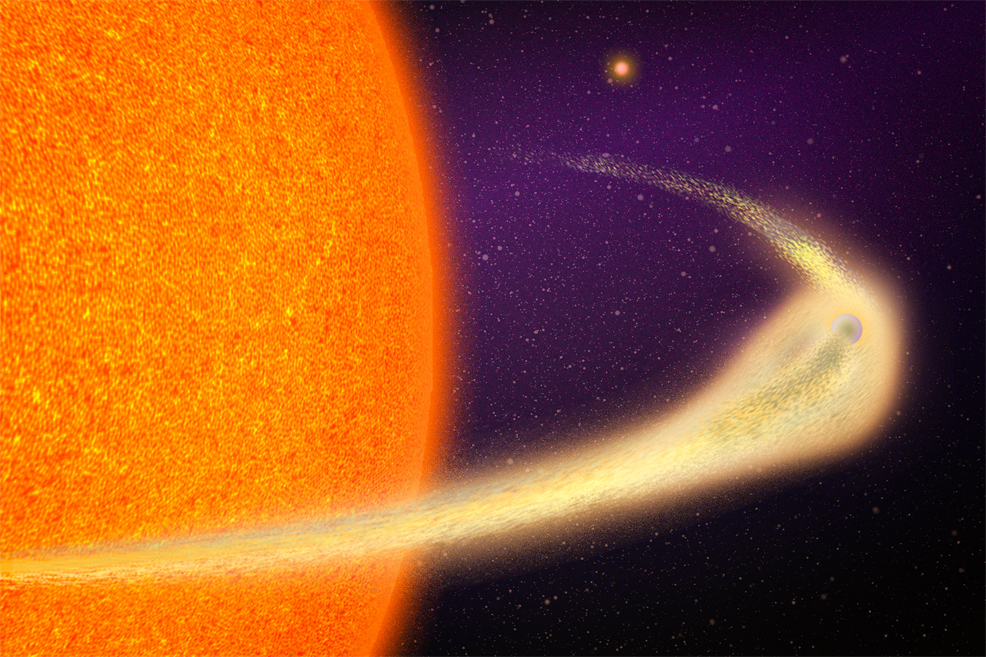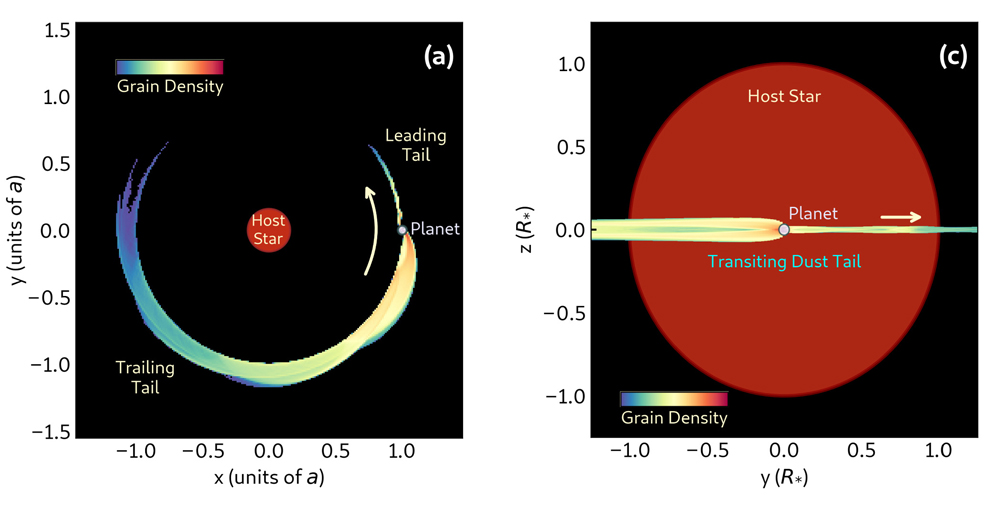
25th April 2025 Exoplanet found with comet-like tail will disintegrate in 2 million years A newly found exoplanet, located 142 light-years away, is rapidly disintegrating as it orbits perilously close to its star. The small, rocky world is trailing a vast, comet-like tail of debris and is shedding a mass equivalent to Mount Everest every 30.5 hours.
Astronomers have identified a dramatic cosmic event seen only a handful of times previously. A rocky exoplanet, BD+05 4868 Ab, located 142 light-years away in the constellation Pegasus, is rapidly disintegrating as it orbits perilously close to its host star. Researchers made this discovery using NASA's Transiting Exoplanet Survey Satellite (TESS), providing a rare opportunity to study the final stages of a planet's life. BD+05 4868 Ab is a small, rocky planet with a mass between that of Mercury and the Moon. It orbits its host star – an orange dwarf named BD+05 4868 A – every 30.5 hours at a distance about 20 times closer than Mercury is to the Sun. This extreme proximity drives surface temperatures to a roasting 1,550°C (2,800°F), causing the planet's surface to melt into magma and vaporise into space. As the planet loses material, it trails a huge, comet-like tail of mineral dust stretching up to 9 million km (5.6 million mi), approximately half of its orbital path. With each orbit, BD+05 4868 Ab sheds a mass equivalent to Mount Everest. At this rate, scientists estimate that it will completely disintegrate and evaporate within 1 to 2 million years.
The astronomers behind this discovery detected the planet almost by chance, during routine data analysis from TESS. They noticed unusual transit signals – periodic dips in the star's brightness – that varied in depth and shape with each orbit. These irregularities pointed to the presence of a disintegrating planet with a substantial dust tail. "The extent of the tail is gargantuan, stretching up to 9 million kilometres," said Marc Hon, a postdoc in MIT's Kavli Institute for Astrophysics and Space Research. "The shape of the transit is typical of a comet with a long tail. Except that it's unlikely that this tail contains volatile gases and ice, as expected from a real comet – these would not survive long at such close proximity to the host star. Mineral grains evaporated from the planetary surface, however, can linger long enough to present such a distinctive tail." "This is a very tiny object, with very weak gravity, so it easily loses a lot of mass, which then further weakens its gravity, so it loses even more mass," explained Avi Shporer, a collaborator on the discovery who is also at the TESS Science Office. "It's a runaway process, and it's only getting worse and worse for the planet." BD+05 4868 Ab is only the fourth known disintegrating exoplanet and the closest to Earth so far identified. Its tail is the longest yet seen and, according to Hon, "its evaporation is the most catastrophic, and it will disappear much faster than the other planets." Its relatively bright host star makes it an ideal candidate for further observation. Future studies, including those planned with the James Webb Space Telescope, aim to analyse the mineral composition of the dust tail, offering insights into the planet's internal structure and the processes driving its destruction. The discovery of BD+05 4868 Ab offers a rare glimpse into the end stages of a planet's life. Studying such worlds can enhance our understanding of planetary formation, migration, and destruction. As researchers continue to analyse the data from TESS and other observatories, they hope to identify more of these ephemeral planets, shedding light on the dynamic and sometimes violent nature of planetary systems. Hon and Shporer, along with their colleagues, have published their results this week in The Astrophysical Journal Letters.
Comments »
If you enjoyed this article, please consider sharing it:
|
||||||









